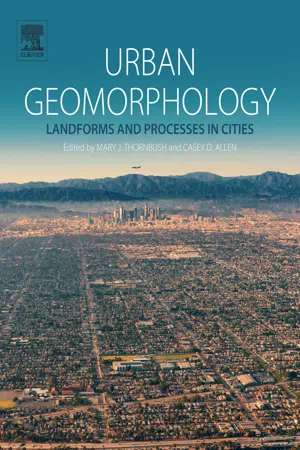
- 362 pages
- English
- ePUB (mobile friendly)
- Available on iOS & Android
About This Book
Urban Geomorphology: Landforms and Processes in Cities addresses the human impacts on landscapes through occupation (urbanization) and development as a contribution to anthropogenic geomorphology or "anthropogeomorphology." This includes a focus on land clearance, conservation issues, pollution, decay and erosion, urban climate, and anthropogenic climate change. These topics, as well as others, are considered to shed more light on the human transformation of natural landscapes and the environmental impacts and geomorphological hazards that environmental change can encompass. Its multidisciplinary approach is appropriate for audiences from a range of disciplines and professions, from geologists, conservationists, and land-use planners to architects and developers. Urban Geomorphology not only transcends disciplines, but also covers varied spatial-temporal frameworks and presents a diverse set of approaches and solutions to human impacts and geomorphological hazards within urban landscapes.
- Features a cross-disciplinary perspective, highlighting the importance of the geosciences to environmental science, engineering, and public policy
- Focuses on the built environment as the location of concentrated human impacts and change
- Provides an international scope, including case studies from urban areas around the world
Frequently asked questions
Information
Introduction
* The University of the West Indies, Cave Hill Campus, Barbados
** University of Oxford, Oxford, United Kingdom
Abstract
Keywords
1.1. Introduction
Table of contents
- Cover
- Title page
- Table of Contents
- Copyright
- Contributors
- Preface
- Chapter 1: Introduction
- Section I: Paleogeomorphology and Archaeogeomorphology
- Section II: Anthropogeomorphology
- Section III: Landscape Influences on Urban Growth
- Section IV: Developing Geomorphological Hazards During the Anthropocene
- Section V: Urban Stone Decay: Cultural Stone and Its Sustainability in the Built Environment
- Author Index
- Subject Index